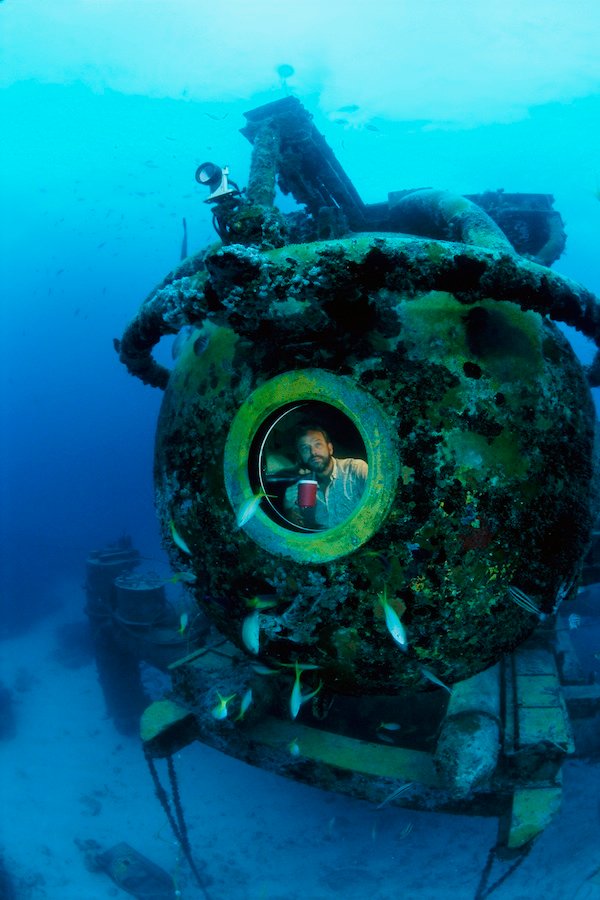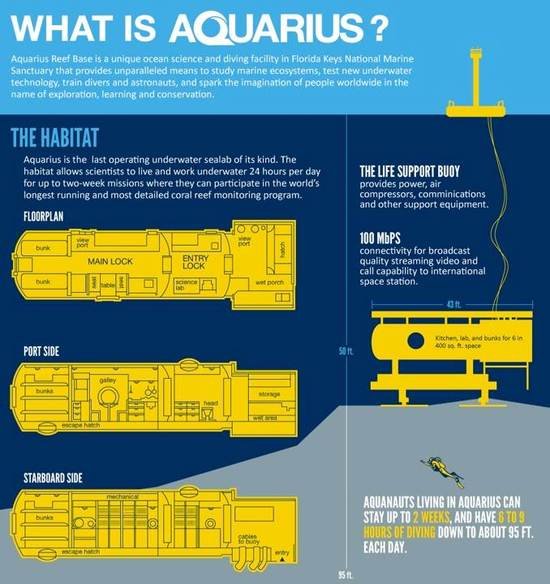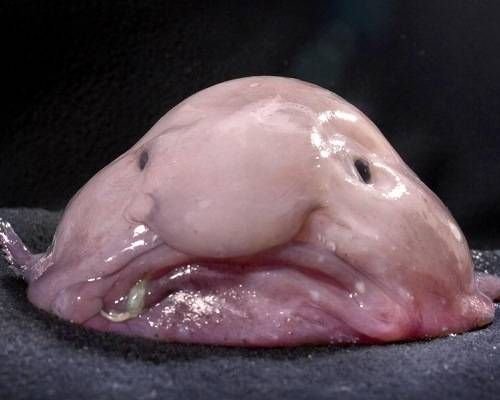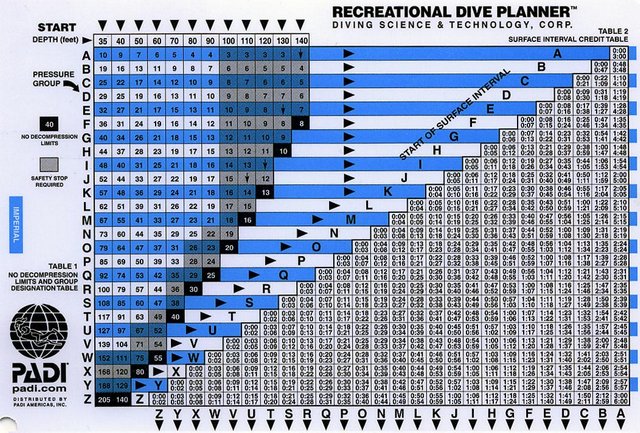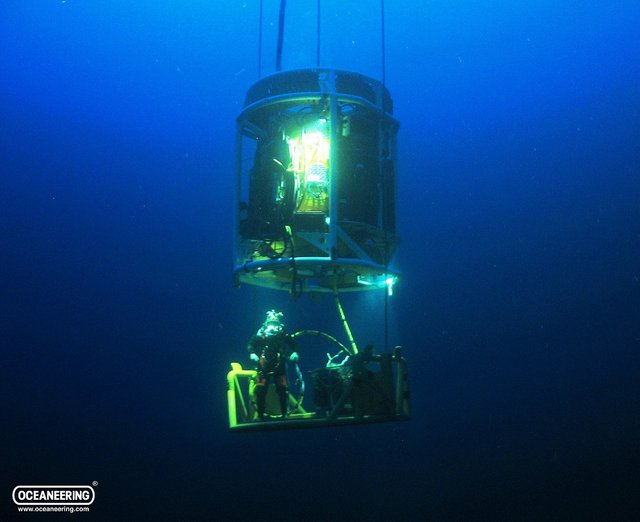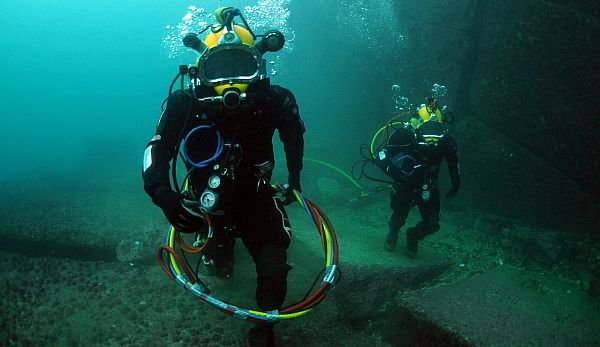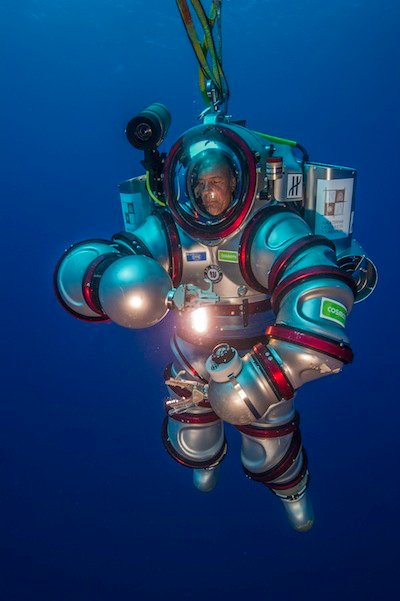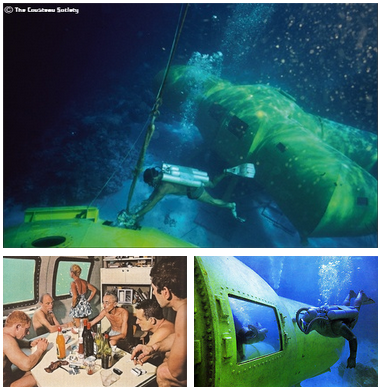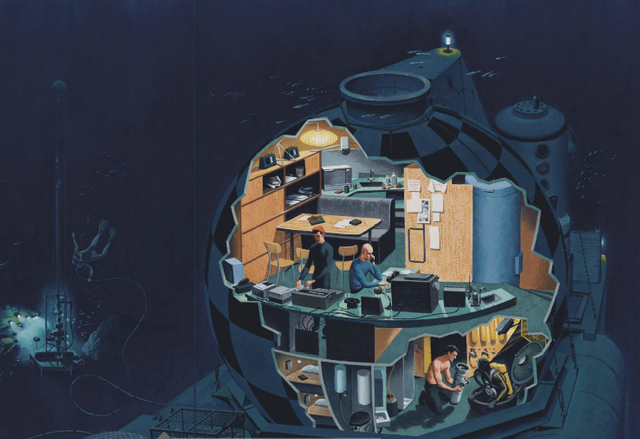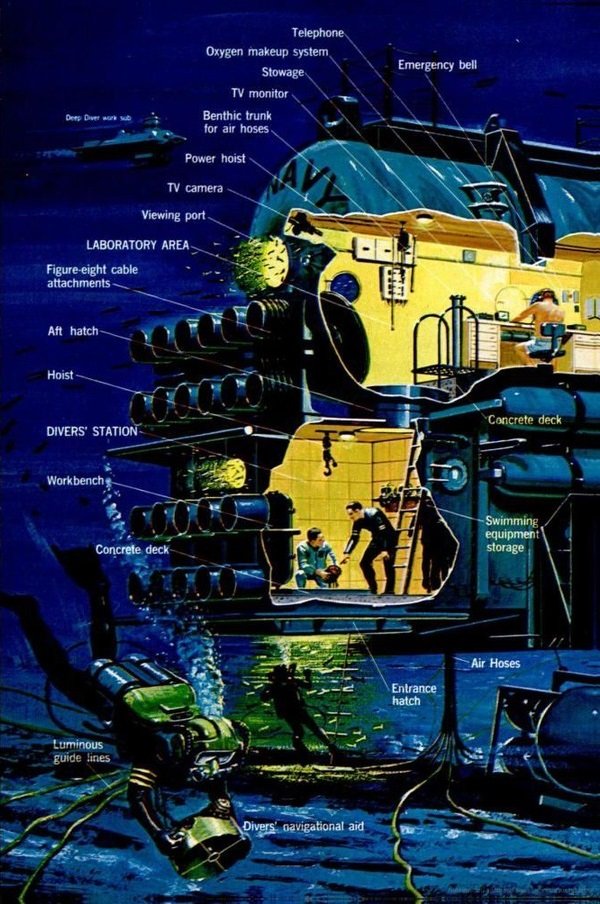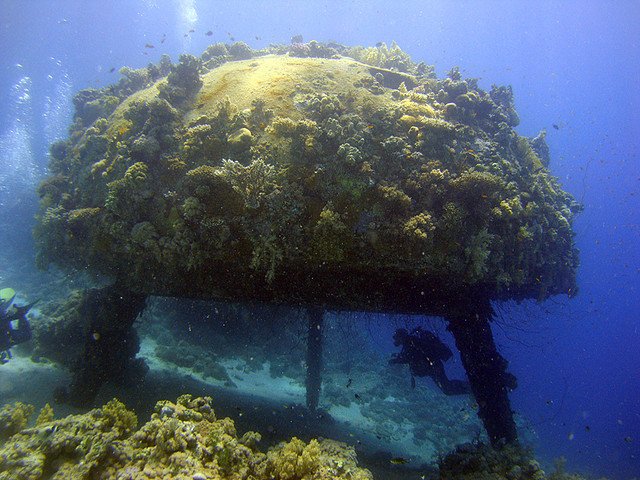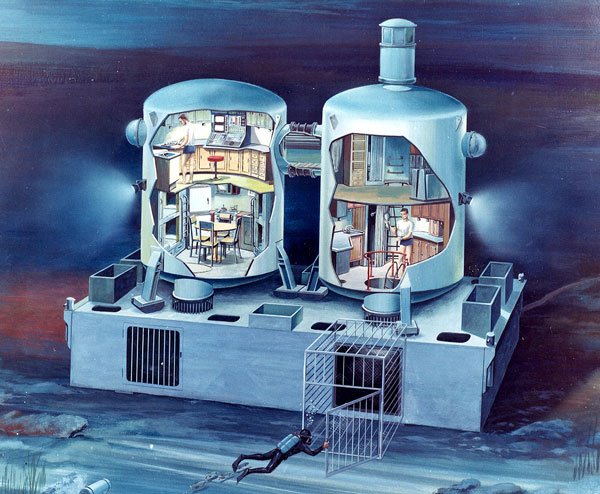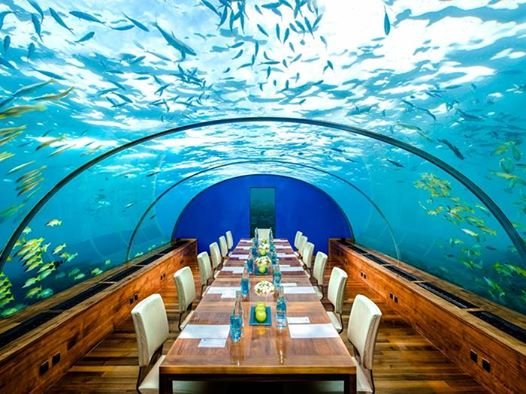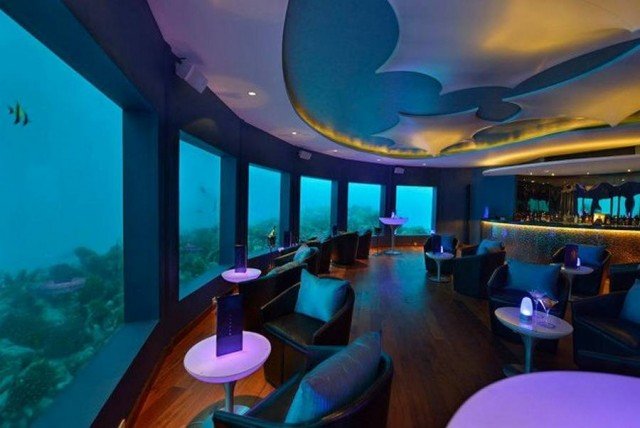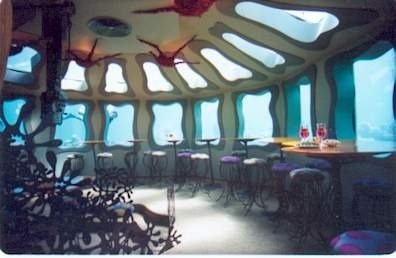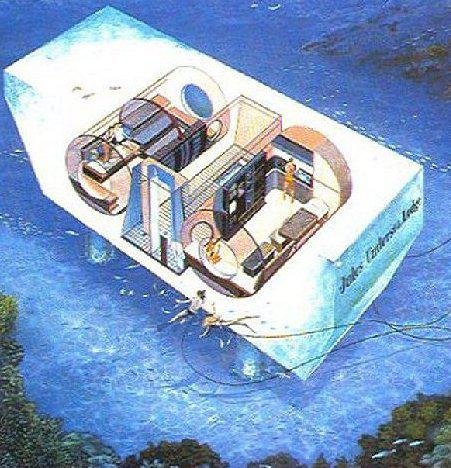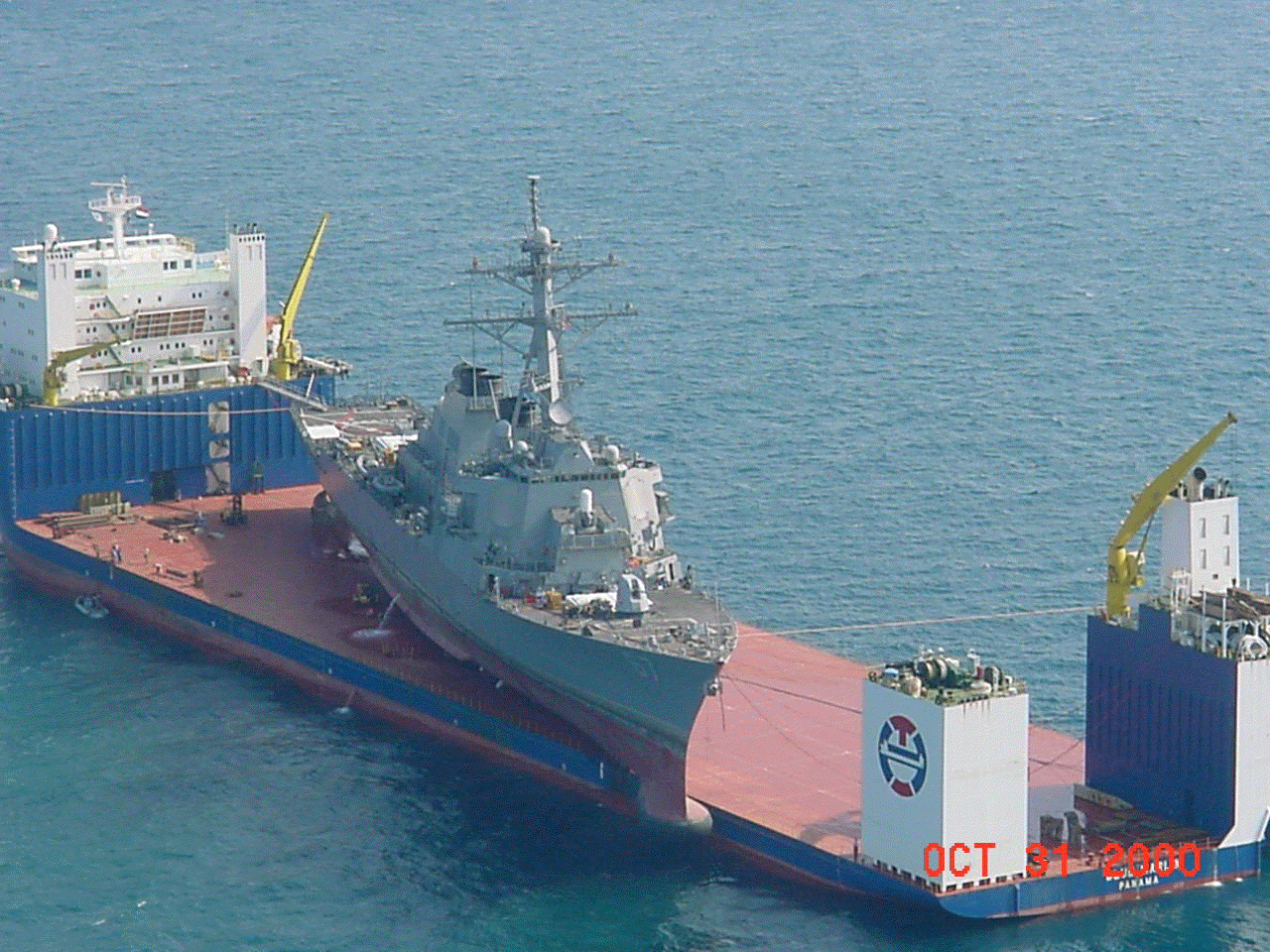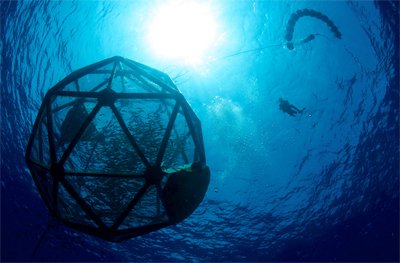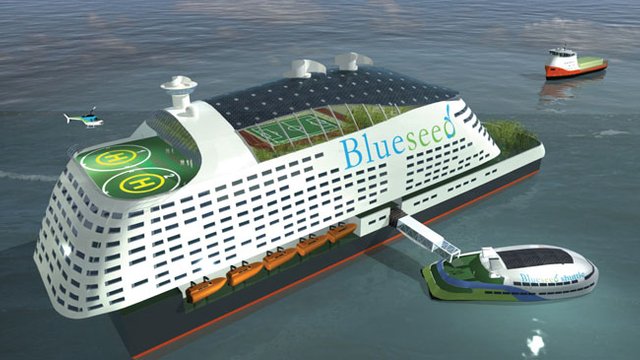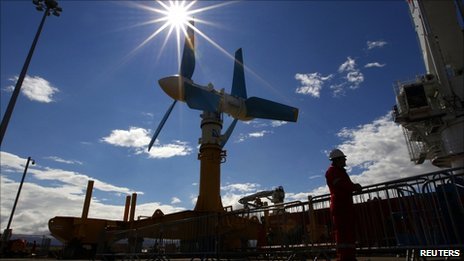SEALAB 2050: A brief history (and future!) of human settlements in the ocean
Underwater habitats have long held a special fascination for me. The notion that there have existed whole buildings on the sea bed, warm dry places with fresh air where you could go and live for a time is like the science fiction pipe dream of every twelve year old boy brought to life.
There have to date existed around 70 manned undersea habitats, depending how large one has to be before you include it in the list. The smallest have been cramped one or two man shelters unfit for anything but the briefest excursions, such as Sunylab, Sublimnos or Biosub. The largest, such as Conshelf 3 and Tektite II, were just a bit larger inside than the average studio apartment.
Currently the only open ocean undersea habitat still in regular scientific use is Aquarius Reef Base. It's a school bus sized steel cylinder situated 62 feet deep, roughly three miles off the coast of Key Largo Florida. The depth was chosen so that the moon pool would be at exactly fifty feet, the limit for using conventional atmospheric air (sent down a by hose from a floating air compressor) as your breathing mixture.
This brings me to the "why" of underwater habitats. Why build such expensive structures? What are they good for? To understand that, you need a crash course in pneumatic and hydraulic principles already familiar to any scuba diver. One common question I've seen which stems from a basic misunderstanding of how water pressure works is "I see an open pool in the floor of these habitats. Why doesn't water rush up inside?"
Of course, this is because the air inside is itself a real physical substance with nowhere to go. As it is equalized with the outside water pressure, the water cannot displace the air. Imagine taking a glass, turning it upside down and pushing it down into water. The air doesn't go anywhere, it's trapped, like a large contiguous bubble.
The further down you push the glass, the more that bubble shrinks, the water line inside the glass creeping upwards. If you were to send down more air via a pump, you could keep the water line where it is, and refresh the air inside the cup faster than human respiration could foul it with CO2. That's the jist of how the simplest habitat life support systems operate.
Water also doesn't simply exert pressure on anything put into it. That is another common misconception. Whatever you put into water will experience force proportional to the difference between the density of the object and the density of the surrounding water. If it is hollow, the force it experiences will be proportional to the pressure differential between the inside and the outside.
This is how soft bodied fish can live at insane depths in the ocean without being crushed by water pressure; there are no pockets of air or any other gas in their bodies that are lower pressure than the surrounding water, and their bodies themselves are the same density as seawater at the depths where they live.
That is to say, they are "equalized" with the surrounding water pressure. Scuba divers undergo this process as well. In order to be able to breathe the air or other breathing gas mixture in their tanks, it must be fed to them at a pressure slightly greater than the surrounding water.
This is done automatically via the regulator. The actual pressure inside the tank is much too high to breathe directly, the regulator steps it down to a level appropriate for any given depth. But this means that a scuba diver is always breathing air, nitrox, hydrox, heliox or whatever at a higher pressure than the air we breathe on land.
When you open a soda, it fizzes because you've released the pressure inside, which was keeping the CO2 dissolved into the liquid. High enough gas pressure in the same chamber as a fluid can force that gas to begin dissolving into the fluid. Then if you release the pressure, the gas bubbles out.
This also happens to scuba divers! Breathing air or other gases at higher than normal pressures causes the nitrogen in those mixtures to dissolve into the diver's blood and soft tissues. This process occurs faster the higher the pressure is. Once enough gas is dissolved into the diver's body, it becomes dangerous to surface, because it will abruptly bubble out of the blood, causing the diver's malady known as "the bends".
This is what dive tables are for. It's a method for calculating how long you can stay at a given depth before you have absorbed a dangerous amount of nitrogen. You can extend your bottom time if you do decompression stops, which means hanging out for about an hour at a time at progressively shallower depths, allowing your body to release the nitrogen at a safe, controlled pace.
But this becomes impractical if you want to dive for not just two or three hours, but up to nine hours per day. That isn't possible without a decompression chamber which divers can live in while the interior atmosphere is gradually reduced at a safe rate which allows the nitrogen to "offgas" without suffering the bends.
Industrial divers work very long shifts on the seafloor, sometimes at depths exceeding a thousand feet. They then return to the diving chamber which is shut and sealed, then winched up to the surface support ship while the interior pressure remains the same as it was down at the dive site. It is then carefully docked to a deckside decompression chamber to provide the divers comfortable living space to dwell in while they undergo the lengthy, tedious decompression cycle.
But supposing you wanted to put teams of divers on a particular site on the ocean floor for very long periods? Say, for the purpose of continuous scientific observation of the effects of oceanic acidification on coral reefs. The ongoing cost of paying the entire crew of a surface support vessel to linger overhead would bankrupt you very quickly.
The alternative is an undersea habitat. Basically, a weighted structure which can support human life on the sea bed with an interior atmospheric pressure that can either be equal to the outside water, or (when the divers need to decompress) slowly reduced over the appropriate period of time, after the hatches have been sealed. Then it is quickly brought back up to pressure, opened back up to the sea, and the divers have ~20 minutes to swim to the surface before they reabsorb a dangerous amount of nitrogen.
This provides the divers someplace other than the surface to return to between dives. A dry, warm living space with an interior pressure that's the same as the depths they dive at, such that the bends are a non-issue. They can safely allow their bodies to fully saturate with nitrogen (absorb as much nitrogen as our blood/tissues will even carry) without fear.
Once they are fully saturated, the amount of time needed to decompress after the mission will not increase any further. At this point they can stay down for however long the mission requires and will still only have to decompress 17 hours when at last it is time for them to return to the surface.
Besides providing space to eat, sleep, use the bathroom, bathe and carry out the other necessities of life, it is also a place where they can refill their scuba tanks. Aquarius also sends pressurized air out to various distant filling stations, so divers can refill their tanks without even returning to Aquarius.
This means their dive time per day is limited only by their physical endurance. The average increase is from 2 hours in the water per day to 9, and that's every day for between two weeks and a month. The alternative approach is to fight pressure rather than adapting to it.
Submarines do this with hulls sufficiently strong to withstand enormous pressure differentials so the inside atmosphere can remain at sea level equivalent regardless of what the water pressure outside is. There has been some movement in this direction in the oil and gas industry, with the development of atmospheric diving exoskeletons.
ADS allow divers most of their normal range of movement and dexterity, though they are somewhat encumbered by the big heavy suit, without ever being exposed to any increase in pressure. It is, in essence, a wearable submersible with jointed limbs. The Nuytco Jim suit, Newt Suit and Exosuit are examples of ADS units.
But I digress! The very first underwater habitat as we would call it today was Jacques Cousteau's "Diogenes", a yellow steel cylinder named after the infamous ancient Greek philosopher who purportedly lived in a barrel, or a wine jar depending on which sources you trust.
It was very austere inside, more like a campsite than the well furnished cozy habitats which came later. Simply designed to test out the physiological effects on the human body of living under pressure, the brief experimental habitat was soon superceded by the far more ambitious Conshelf 2.
Conshelf 2, famously depicted in the documentary "World Without Sun", consisted of not one but three habitats on the same site, 33 feet deep in the Red Sea. The first structure, "Starfish house", was the main living area for six aquanauts...and a parrot, for mysterious French reasons.
The second structure was a dry hangar for the "diving saucer", Cousteau's research minisub. It could surface within this hangar and be winched up entirely out of the water, where it could then be disassembled for thorough maintenance and repair, as well as basic service like recharging the batteries or refilling the O2 tanks.
The third structure was the "deep cabin", a two man habitat situated at a depth of 90 feet which resembled a vertically oriented buoy. It was divided between two floors, the "wet porch" where aquanauts entered and exited via the moon pool in the bottom, and the living area on the floor above which was accessible by ladder.
This remains in many ways the most ambitious underwater living experiment ever conducted. Alas it was financed by the French oil industry in the hopes of establishing manned undersea oil rigs, which Conshelf 3 (Cousteau's next habitat project) was a prototype for:
Cousteau later renounced these projects, saying that he witnessed too much degradation of the oceanic environment by pollution to facilitate human colonization of the ocean in good conscience. This betrayal soured the oil industry to the idea of underwater habitats for oil extraction.
While there are fully submerged oil rigs today, they are automated with no humans that live within them, and the oil industry discovered it was cheaper to put the "habitat" (decompression chamber) on the deck of a ship and ferry aquanauts between there and the worksite below via diving chambers than it was to establish fixed habitats on the seafloor.
Cousteau's habitat program inspired many copycats. The Navy's Sealab program, famously. The name became the basis for a cartoon you are no doubt familiar with. Sealab 1 was a dull, spartan steel cylinder which had many technical problems with the plumbing, heating and more.
Sealab 2 rectified most of the design flaws of Sealab 1 as well as increasing the available living space. It was home to a great many aquanuts over its lifespan including several, like Scott Carpenter, who were also astronauts either before or afterwards.
Having conducted Sealab 1 at 200 feet and Sealab 2 at over 300, the next step was Sealab 3 at roughly 600 feet. Sadly it was scrapped when one of the divers, Barry Cannon, died due to an apparently sabotaged rebreather unit. The culprit was never identified but suspected to be a Soviet mole.
This is because the true purpose of the Sealab program was to establish bases for divers to remain saturated and at the ready should Soviet subs be disabled in US waters, such that the divers could salvage technology from them before they became unsafe due to reactor leaks.
The other purpose was to house divers working on tapping into undersea communications cables. As ever, the oil industry and the military industrial complex had the kind of cash necessary to finance the construction and deployment of these marvelous structures, and when they lost interest in human settlement of the sea, that endeavor largely died out.
Just as there was a long, disappointing lull in manned spaceflight activity following the Moon landings, so too was there a lull in manned undersea activity. Most of the habitat projects in history were between 1965 and 1979. Almost all were removed from the sea and scrapped to recoup some of the expenses. The submersible hangar of Conshelf 2 remains in place, but was deliberately flooded to discourage divers from trying to live in it:
Other notable projects of that "golden age" of man in the sea projects include Tektite, a General Electric habitat built as a space station simulator, La Chalupa, which was later repurposed as the world's only fully underwater "hotel" (though it has but two bedrooms) Chernomor, a Russian habitat plagued by poor design choices, Helgoland, a German habitat, Seatopia, a Japanese habitat and Hydrolab, the NOAA's habitat prior to Aquarius and the only one ever to include a docking port for submersibles.
Hydrolab was absurdly cramped inside but is among the most thoroughly used habitats in history, having hosted more than 500 people. It has produced many "firsts", such as the first surface-independent operation of an undersea habitat by the use of a submerged hydrogen fuel cell which met the habitat's needs without relying on the usual surface buoy, as well as being the only habitat to be operated primarily in one atmosphere (sea level pressure) mode.
La Chalupa is available today to any tourists willing to spend $600 to spend the night, though it is a flat rate which can be split up to 6 ways, so if you have 5 friends willing to go with you, it can be as cheap as $100 per person. The habitat, now called the "Jules Undersea Lodge" sits in 30 feet of water, an inland emerald lagoon, next to Marinelab.
Marinelab is a research habitat operated by the Marine Resources Development Foundation, funded by the revenue from the Jules Lodge. It is relatively small, comparable to Hydrolab but with a transparent spherical glass observatory attached.
You may be thinking "hang on a minute, I know I've seen something about a fancier underwater hotel in Dubai or something". You have seen CGI renders but not a finished structure. Every few years there are "plans" for an underwater hotel in Dubai, Fiji or the Maldives like the Poseidon Undersea Resort, Hydropolis, etc. but nothing ever gets built. I hope that changes but for the time being there's just the Jules.
Various small, extremely shallow water undersea tourist attractions do exist however. The Ithaa undersea restaurant is a mostly transparent acrylic one room restaurant with about a dozen tables. It is just 15 feet deep, as it the norm for attractions of this time, and is accessible via an enclosed stairwell from the surface rather than diving.
There's also the Lime spa at Huvafen Fushi, a similarly sized undersea spa and massage parlor. It's in the Maldives along with many of these small touristy dealies. There's the Water restaurant, still in just 15 feet of water but impressively large, among the largest submerged buildings ever constructed.
Then there's the Red Sea Star, a former underwater restaurant in Israel which later became a strip club, but then shut down due to not being able to cover maintenance expenses. Little oddball underwater attractions like this do exist around the globe but are not proper underwater habitats in the sense of the other structures discussed so far.
For a much more complete and detailed description of all of the major habitats built between Diogenes and Aquarius, I encourage you to buy a copy of Living and Working in the Sea by James Miller and Ian Koblick (owner of the Jules Lodge! Small world)
Erik Seedhouse has written an excellent book, Ocean Outpost, about Aquarius Reef base and the future of open ocean habitats of its kind. Then lastly, Dennis Chamberland's "Undersea Colonies" is a wonderful primer on the technologies needed to support large numbers of human beings underwater and the potential for future seafloor settlements of dozens, hundreds or more.
Despite the accelerating replacement of human divers with ROVs (remotely operated vehicles, aka aquatic dones) there remain many profitable applications for undersea human living spaces. The Chinese Government recently fast tracked the construction of a "massive" deep sea facility which will initially house 12, expandable to 33, at a depth of up to 9,800 feet.
The purpose will be to support deep sea mining. While the actual mining is done by enormous robots, they still have to be controlled by somebody. Most of the companies like Seacor, Nautilus Minerals and Neptune Minerals now angling to dominate the emerging deep sea mining industry plan to do it like this, operating the robots via miles-long fiber optic tethers from a surface support vessel.
This is only feasible in relatively calm regions of the sea. Where surface conditions are typically violent, it is unsafe to have even a very large ship loitering overhead. Besides the danger, there is also the cost of paying the full crew of such a ship to hang out above you doing very little for long periods. While less costly than building, deploying and operating such an ambitious undersea facility, the surface weather problem just barely makes the difference.
In the Chinese model, the human crew members of the expansive, spacious habitat would operate the robots from within it. In fact you only need to go about 200 feet down before all influence from surface storms vanishes, due to how waves work. It is as yet unknown why the Chinese government wants to build the structure unnecessarily deep. Speculation includes scientific and military purposes, given their recent activities in the South China Sea.
You can bet that if the Chinese venture proves successful, other governments will follow suit in order to carve out a piece of the lucrative oceanic resource development pie. But for underwater living to become truly commonplace, it must become much, much cheaper. A titanium 1 atmosphere habitat at 9,800 feet is going to be astronomically expensive.
Much in the same way that SpaceX innovated methods for bringing down the cost per pound of sending mass into orbit, we will need to devise methods for reducing the cost per cubic foot of underwater living space if any significant number of people are ever to live beneath the waves.
Having studied this matter for the better part of a decade, I've found that the largest reducible expenses are not where you might expect. Not in the materials, not the life support technology, but in the sheer weight necessary to keep these structures from floating.
Air is monstrously buoyant. It requires 64 pounds just to cancel out the buoyancy of one cubic foot of air. Then more weight beyond that to securely emplace it on the bottom, unless it is so deep that currents are not a concern. For example, Aquarius Reef Base weighs 116 tons in total, most of which is the lead ballast needed to weigh it down. That's just for a school bus sized lab that supports 6 people in pretty cramped conditions.
This is the reason why, historically, undersea habitats have not been any larger than absolutely necessary for their intended application. The larger it is inside, the more air you have to counteract with more ballast weight. Most of the habitats ever built were transported by rail car from where they were built to the shore.
There, they were loaded aboard the deck of an A-frame ship. They needed to be small enough, then, that the A-frame crane could fit over them and lift them off the deck and into the water. The few which did not fit aboard such ships were typically designed to be towed in the water, like Conshelf 3 or La Chalupa.
La Chalupa's design was particularly clever. The living space consists of two cylinders with a rectilinar wet porch room between them for moon pool access. Then a much larger barge shaped steel shell around that. The space between the outer shell and the actual living spaces was filled with concrete, which was then allowed to harden. This supplied the necessary weight.
However a pair of submarine-like ballast tanks were also included in the shell, embedded in the hardened concrete. When full of air, these tanks ensured the La Chalupa would float, and could be towed like a barge, hence its shape. When they were filled with water, the La Chalupa was no longer buoyant enough to float and could sink at a carefully controlled rate down to the sea bed.
This made it uniquely simple to reposition as needed. Conshelf 3 could also surface itself in this manner but was considerably more ungainly in design and thus less efficient to tow. I think the La Chalupa design is almost ideal for future habitats.
I say almost because it is still unbelievably heavy and thus difficult and expensive to transport over land. I propose solving this by eliminating the use of concrete. Instead the habitat is towed out to where it will be sunk, then sand from the seafloor is suctioned up using a dredge pump and deposited into the empty space between the living space and the outer shell of the habitat.
Once full of sand, the ballast tanks can be gradually allowed to fill until it is negatively buoyant, whereupon it can be carefully guided down to the seafloor by a team of divers or labor submersibles like the Nuytco Deepworker 2000 series.
As an alternative to towing, semisubmersible ships exist capable of lifting entire oil rigs up out of the water and transporting them. Were underwater living to become sufficiently popular and lucrative, it would become economical to make use of these ships, which would vastly increase the possible size of a single colony module.
The deck size of a semisubmersible ship of the type discussed here is comparable to a football field. It would make possible single huge enclosed habitats of an unprecedented size, which could then be interconnected once on the seafloor to form truly vast undersea settlements supporting thousands, tens of thousands, even hundreds of thousands.
The expenses associated with ballast weight can be largely negated by the dredging method, and by the design principles employed by the La Chalupa. But there is still an unavoidable cost differential between fully 1atm and ambient pressure designs.
This is because a structure which must at all times resist substantial outside water pressure can only be spherical or cylindrical and must have a thick hull made from steel or titanium. By comparison an ambient pressure habitat which is equalized at all times with the outside pressure can be as simple and flimsy as a welded metal box.
A box? Insanity, right? It would be crushed. Not so! Because it's ambient pressure there is no pressure differential to crush it. The only stress on such a structure is the buoyancy of the air inside. It can be almost any shape you like, and can be built to a much cheaper, more lax standard than a 1atm habitat without compromising safety.
Of course if your colony is ambient pressure, it can be no deeper than a moon pool depth of 50 feet. Otherwise oxygen toxicity kicks in and you have to begin using expensive breathing gases like heliox and hydrox to counteract it. 50 feet is not nearly deep enough to escape danger from hurricanes and other violent surface weather, as well.
This can be overcome with significant overballasting, pilings driven into the sea bed and other measures of more securely fixing the structure immovably to the sea bed. These supports should include shock absorbers, like "quake proof" buildings so that earthquakes do not damage hull integrity.
Finally, such a colony would require several decompression chambers for families wishing to visit the surface. These would need to be large and well appointed enough to comfortably spend 17 hours in pending a trip, possibly via docking submersible, to the coast.
This is not the ideal undersea colony design, just the cheapest. There are many physiological and practical reasons why you might instead wish the entire colony to be at one atmosphere all the time, not the least of which is that you could then board a sub and travel to shore without the long wait of decompressing.
This National Geographic documentary showcases such a design and explores the challenges involved in establishing such a colony, as well as interviewing some of the authors and diving legends I've mentioned in this very article, like Dennis Chamberland and Phil Nuytten of Nuytco.
Economics rules, and if it isn't profitable, it won't last. My search for profitable oceanic activities which require or could be made more efficient and productive by the addition of saturation diving habitats (like the Aquarius) led me to conclude that mariculture is the most likely candidate.
Mariculture is just open ocean aquaculture, in which fish or other edible marine livestock are cultivated in floating netted enclosures such as this one. It's built by Oceanspar technologies and used by Kampachi Farms, formerly Kona Blue.
The ocean is not "first come, first serve" where operations like this are concerned. They must negotiate with the ISBA with respect to how much area their farm will occupy, which establishes limited "borders" within which to cultivate their product.
This incentivizes vertical farming; stacking enclosures of the type you have seen down into the sea. This increases the depth divers must work at as they inspect, maintain, repair and harvest.
Increased depth means faster nitrogen saturation. Which increasingly limits the amount of work individual divers can perform at depth in a given day. Right now, most mariculture operations are fairly compact and can be serviced by small teams of scuba divers operating out of boats which carry them between land and the work site.
However as these farming operations scale up in size, they will reach an inflection point where it begins to be cheaper to house divers in a seafloor saturation diving habitat which allows a small number of divers to get the same amount of work done in a day that would normally require many times more divers on the payroll.
We're not talking whole colonies. I still cannot imagine a viable business model for that. Just four to six person habitats similar to the Aquarius, but for commercial purposes. If large populations ever live out to sea, it will be in floating "seasteads" on the surface of the ocean rather than beneath it.
Artificial floating living space, while still expensive, is much cheaper than underwater living space. If you have seen elaborate futuristic CGI renders of floating ocean cities, banish the notion from your mind. Economics rules. It would be cheaper by far to utilized after market cruise ships.
This is in fact the chosen approach of Blue Seed, the company furthest along in its seasteading ambitions. A cruise ship already includes almost everything you'd want an autonomous floating ocean community to have. Retrofitting it for stationary use only requires minor modifications like larger fresh water tanks, solar panels, wind turbines and so forth.
Blue Seed's business model involves establishing a floating office park where Silicon Valley entrepeneurs can meet and collaborate with Chinese engineers and investors without the hassle of Visas and the other beaurocratic hoops one must leap through in order to enter the US mainland.
While less sexy than the scifi seastead concepts you may have seen, after market cruise ships are an efficient, economical option. They have already paid for their construction many times over during their useful lifespan as cruise ships, carrying paying passengers.
The decor and technology may be out of date, between 1970s and 1990s, but the quality of living space aboard them is still far and away more luxurious than what most are accustomed to. The shared public spaces in particular are much nicer than the concrete and asphalt outside your window if you live in a city.
The families of maricultural laborers could live in such a stationary, repurposed cruise ship "seastead" which could house and power the air compressor, water heater and other support machinery for the habitat(s) on the sea bed below. This symbiotic arrangement would allow a high standard of living independent from shore provided a diverse variety of profitable offshore activities.
Besides mariculture, this might include inspection, maintenance and repairs of offshore wind turbines, seafloor current turbines and wave generators. It would undoubtedly include tourism, and possibly (depending on location) seafloor mining, though all but a few viable mining sites are in much deeper water.
That is the extent to which I anticipate that true offshore oceanic settlements are likely to exist in our lifetimes. The means to reduce the cost of ambient pressure undersea living space exist, but the economic motive to build such dwellings any larger than absolutely required for applications that require saturation diving do not exist as yet.
That is unless some eccentric, reclusive billionaire one day tires of the surface parasites, and invites a select few to choose the impossible...
